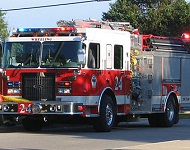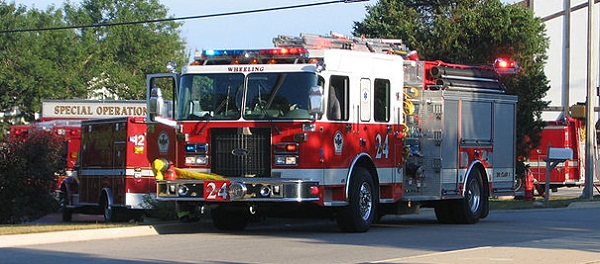

By Michael Morse
The first time I drove a piece of fire apparatus to a fire incident, I nearly wiped out everyone on scene. The second story of a three-level house was fully involved, a man in a wheelchair was trapped on the first floor, and a lady with an infant struggled to escape the third floor. Engine Co. 10 was out of their district. My truck—the 2s—were covering.
It was my first day driving the vehicle. Our regular officer was out and a callback officer sat in his place. He had no idea how green I was and, as it turns out, neither did I. The stillbox came in at 1000 hours, a few streets from where we were conducting a fire extinguisher drill. We roared toward the smoke, the sound of sirens enveloping the city as six companies sped toward the incident. I turned down the dead-end street where the fire was. Cars were parked on both sides; some stopped directly in front of the occupied house fire.
Great idea, right? Ladder Co. 5 didn’t think so, nor did Engine Co. 11, which was trying to do a reverse lay from my truck to a hydrant 200 feet in front of me. My efforts managed to block the road to all responding apparatus, making a difficult job nearly impossible and forcing our crews to work much harder than they should have.
Tunnel vision happens. Fortunately, my department adheres to the philosophy that “Plan A is great, Plan B is always ready, and Plan C is to do whatever needs to be done in case an idiot blocks the road!” The people were rescued, the fire went out, and I lived to learn how to fight fire and spot apparatus another day.
One of the most important aspects of an effective emergency medical services response is apparatus placement. In fact, placement is key to the successful outcome of many emergencies to which we respond. More often than not, the advanced life support engine company is first on a fluid scene. When the call is for a single patient in a single-family home on a desolate street, the chance of screwing up is slim.
RELATED: Gustin on Positioning Apparatus for Maximum Efficiency and Safety ‖ Adams on Apparatus Load Balance Guidelines ‖ Dunne on Apparatus Positioning
Responding to a high rise in a congested area is a little more challenging. A motor vehicle accident in the high speed lane after the nightclubs have closed can literally be a matter of life and death for both victims and responders.
The ability to see the future of a call comes easily for firefighters who have responded to similar calls for many years. Most company officers are experienced and capable. They know exactly where to put the truck. Newer firefighters do not see the future of the call as easily as those who have been there. They cannot envision the ambulance arriving on scene minutes after they do and having to leave their vehicle in an awkward place.
Keeping the path clear for the next-due crews becomes second nature. A well-trained engineer or driver anticipates incoming companies and spots the apparatus accordingly.
Five things to remember when spotting apparatus:
- Anticipate incoming apparatus, and leave room for the ambulance crew.
- Stay out of the way by pulling forward or stopping before the patient’s house.
- Always have a means of egress.
- Use the vehicle as a shield on roadways—spot apparatus in front of the accident scene by taking up two lanes (if prudent) while leaving room for the ambulance closest to the wreckage.
- Be ready to operate any fire department vehicle on scene (see http://emberly.fireengineering.com/articles/2015/06/i-need-a-driver.html)
We often overlook the simplest things. A good engine company recognizes that little things make a big difference when responding to emergencies. A poorly placed truck gets in the way, makes the job at hand harder, and is simply an example of poor firefighting.
Talking about the little things helps everybody in the company. We all want to look our best; overlooking the small stuff is never going to make anyone shine. Looking sharp is often simply a matter of communication before the alarm.
More Fire EMS
The Sample Survey
Protecting Patients from the Dirty Work of Firefighting
Engine Company EMS: What Are We Going to Do Now?
Quit Wasting Time on Your Devices and Learn Something Useful!
 Michael Morse is a former captain with the Providence (RI) Fire Department (PFD), an author, and a popular columnist. He served on PFD’s Engine Co. 2., Engine Co. 9, and Ladder Co. 4 for 10 years prior to becoming an EMT-C on Rescue Co 1 and Captain of Rescue Co. 5.
Michael Morse is a former captain with the Providence (RI) Fire Department (PFD), an author, and a popular columnist. He served on PFD’s Engine Co. 2., Engine Co. 9, and Ladder Co. 4 for 10 years prior to becoming an EMT-C on Rescue Co 1 and Captain of Rescue Co. 5.

